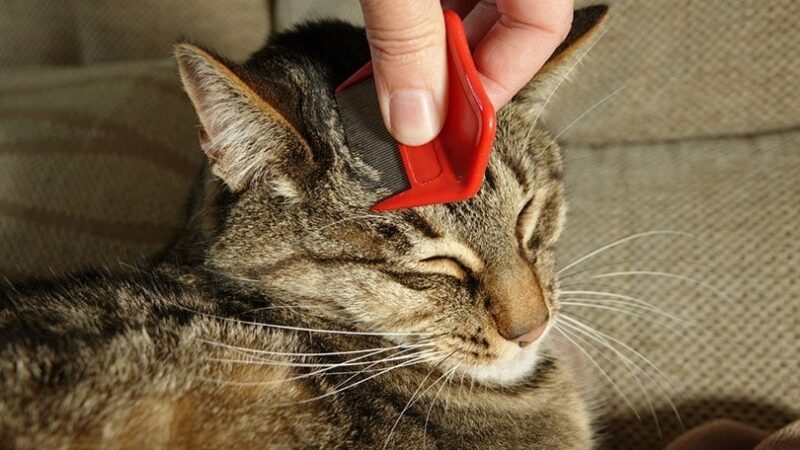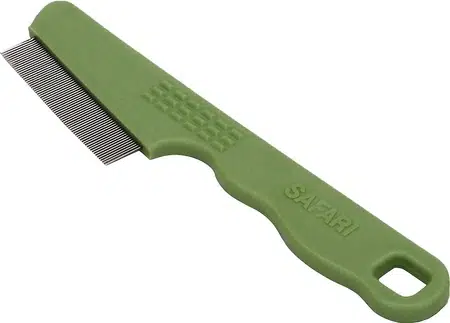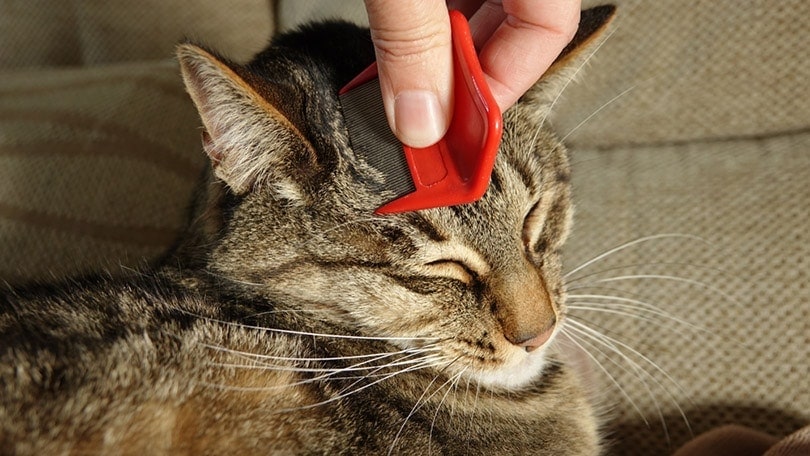
Caring for your feline friend involves more than just feeding them and ensuring they get regular check-ups. One major aspect of pet care is grooming, which includes dealing with pests like fleas that can cause your cat discomfort and health issues. A great tool to tackle this issue is a flea comb.
This simple, efficient device helps identify and remove fleas and ticks from your pet’s coat while promoting overall skin health. With a plethora of options available in the market, we’ve shortlisted the top flea combs for cats this year to help you make an informed choice for your pet’s needs.
A Quick Comparison of Our Favorites in 2024
| Image | Product | Details | ||
|---|---|---|---|---|
| Best Overall |
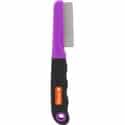
|
Hartz Groomer’s Best Flea Comb |
|
CHECK PRICE |
| Best Value |
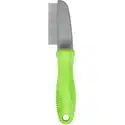
|
Frisco Single-Row Mini Flea Comb |
|
CHECK PRICE |
| Premium Choice |
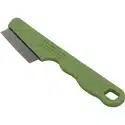
|
Safari Flea Comb for Cats |
|
CHECK PRICE |
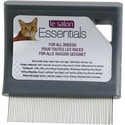
|
Le Salon Essentials Flea Cat Comb |
|
CHECK PRICE | |
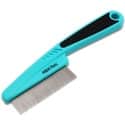
|
H&H Pets Pin Comb 2.0 |
|
CHECK PRICE |
The Best 10 Flea Combs for Cats
1. Hartz Groomer’s Best Flea Comb – Best Overall

| Material: | Metal, plastic, rubber coating |
| Features: | Tough grip, safety tips |
| Weight: | 2.08 ounces |
The Hartz Groomer’s Best Flea Comb is a versatile tool that offers a highly effective and gentle way to combat fleas. It’s equipped with extra-fine teeth that meticulously catch adult fleas, eggs, and other debris in every stroke, ensuring a clean, healthy coat for your pet.
What’s more, this essential tool doubles as a groomer, enabling you to manage mats around delicate areas such as your pet’s face and paws.
Designed for both cats and dogs, the comb comes with safety tips on every pin, making it extra gentle on your pet’s skin. Its ergonomic handle ensures comfort and control during grooming, reducing strain and fatigue. With a weight of just 2.08 ounces, it’s light and easy to use.
- Highly effective at removing fleas and eggs
- Doubles as a grooming tool
- Gentle on pets’ skin
- Ergonomically designed handle
- May require frequent use for severe infestations
- Effectiveness may vary based on fur type
2. Frisco Single-Row Mini Flea Comb – Best Value
| Material: | Rubber, metal, plastic |
| Features: | Soft-grip handle |
| Size: | 7.49 x 1.66 inches |
The Frisco Single-Row Mini Flea Comb is a fantastic choice for smaller pets. Finely spaced and rounded pins glide smoothly through fur, not only catching pests like fleas and ticks but also helping identify hard-to-see skin conditions.
Comfort is at the forefront of this comb’s design, featuring a soft grip handle for better control and an easy-to-use structure, enabling effective brushing from head to tail. Beyond just a pest remover, this comb is also an effective grooming tool, contributing to a healthier coat.
Like other Frisco products, this mini flea comb is crafted for the best possible experience for you and your pet. You’re sure to get your money’s worth, thanks to its comfort and effectiveness.
- Effectively identifies and removes pests
- Comfortable and easy to use
- Suitable for identifying skin conditions
- Ideal for small breeds
- Might require more passes for heavily infested pets
- Not as effective on large or long-haired breeds
3. Safari Flea Comb for Cats – Premium Choice
| Material: | Plastic, metal |
| Features: | Contoured grip |
| Weight: | 1.6 ounces |
The Safari Flea Comb for Cats is specifically designed to cater to feline needs. It’s an excellent tool not only for pest control but also for identifying skin and coat problems in cats.
The comb’s design is highly thoughtful—it’s contoured to fit comfortably in your palm for better control, making it easier to brush from the head down to the tail of the cat. Furthermore, its fine teeth effectively remove pests without irritating flea-bitten skin, ensuring a comfortable grooming experience for your pet.
One of the major benefits of this comb is its utility in assessing the effectiveness of flea control products. You can use it post-application of flea powders or shampoos to check whether these products are working properly. Plus, the close spacing of the teeth allows you to examine the overall condition of the coat and spot any dry skin or other problems.
- Works well with other flea control products
- Excellent for pest control and identifying skin issues
- Feels tough and durable
- Comfortable design for better control
- May not work as effectively for larger breeds or dogs
- May require more passes on heavily infested pets
4. Le Salon Essentials Flea Cat Comb
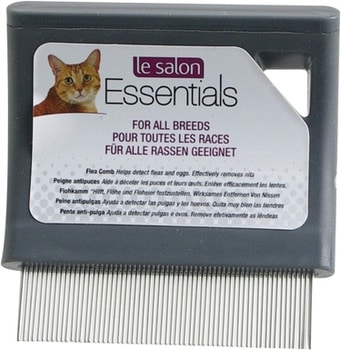
| Material: | Plastic, metal |
| Features: | Square-shaped grip |
| Weight: | 1.28 ounces |
If you’re looking for a flea comb that offers a gentle and thorough comb-through, the Le Salon Essentials Flea Cat Comb is a solid choice. It is designed to effectively remove fleas and their eggs from your cat’s coat, providing a comfortable grooming experience for your pet.
One of the key features of this comb is its versatility. It can work on coats of all types and lengths, making it suitable for most cat breeds. Whether your cat has a short, medium, or long-haired coat, this comb can handle it all.
The Le Salon Essentials Flea Cat Comb also prioritizes your cat’s comfort, ensuring the grooming session is as stress-free as possible. It has a gentle yet effective operation, making it a suitable choice for cats that may be nervous or uncomfortable during grooming.
- Gentle and thorough comb-through
- Works on all types of coats
- Ideal for most breeds
- Effectively removes fleas and their eggs
- The grip may not be as comfortable as some other options
- Fine teeth may require frequent cleaning during heavy infestations
5. H&H Pets Pin Comb 2.0
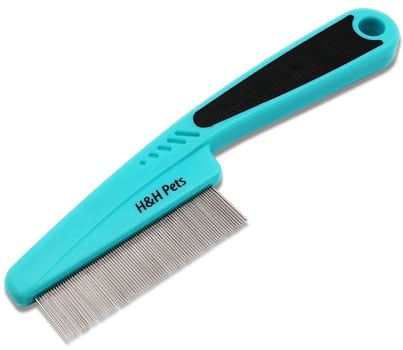
| Material: | Rubber, plastic, metal |
| Features: | Anti-slip handle grip, stronger teeth design |
| Weight: | 2.08 ounces |
Designed with pet owners in mind, the H&H Pets Pin Comb 2.0 offers a quality grooming experience. The comb utilizes a higher-grade metal for the teeth, which ensures durability and resilience. This updated design significantly surpasses its previous model in terms of strength.
The comb boasts a rubber-sheathed handle, too, which replaces the typical hard plastic handle seen in other models. This anti-slip design enhances comfort while allowing for a smoother grooming process. It also serves to prevent accidents during grooming.
It’s worth noting, though, that the comb should be used on clear fur; using it on heavily matted fur might lead to damage. Given its suitability for all breeds, hair lengths, and various animals, this comb offers versatility that’s hard to beat.
- Upgraded, durable teeth design
- Comfortable, rubber-sheathed anti-slip handle for easy grooming
- Suitable for all breeds and hair lengths
- Regular use provides health benefits
- Not suitable for heavily matted fur
- Some teeth may bend despite the strong design
6. Yumflan Flea Comb with Rubber Handle
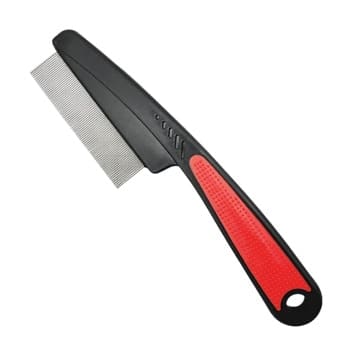
| Material: | Metal, rubber |
| Features: | Anti-slip handle, high-quality metal pins |
| Weight: | 1.45 ounces |
The Yumflan Flea Comb is another top-notch grooming aid for your cats, although it’s suitable for other small animals, too. This version sports high-grade metal teeth, ensuring it is stronger and more durable than others in its class.
You get a rubber-sheathed handle, which is designed for a comfortable grip for easier pet grooming tasks. There are around 30 teeth per inch, with a length of 3/4 inch, making it suitable for long-haired dog breeds, as well.
Early detection of fleas becomes easy with this comb, allowing you to take timely action to prevent further spread and infestation. While the comb is highly functional and the teeth are designed to be stronger, breakage can occur. Still, it’s an affordable and versatile option that works well.
- Helps maintain pet health by removing small objects and dandruff flakes
- Suitable for various animals and all coat types
- Made of high-quality, durable metal
- Rubber-sheathed handle for anti-slip grip
- Better suited to adult cats
- Teeth breakage is possible
7. Pet Republique Flea Comb for Dogs & Cats
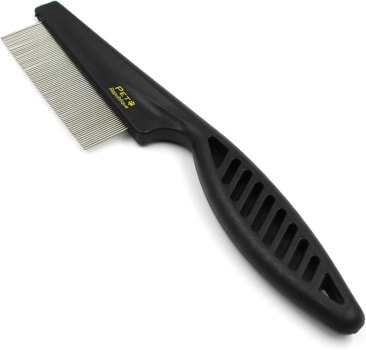
| Material: | Plastic, metal |
| Features: | Finely spaced teeth, ergonomic grip |
| Weight: | 0.80 ounces |
The Pet Republique Flea Comb is a reliable tool for removing fleas, mites, ticks, and their eggs from your pet’s coat. It’s also a great comb for helping remove excess hair, knots, and dandruff, effectively reducing shedding and saving you from constant vacuuming.
One notable feature of this comb is its improved ergonomic grip and firm yet flexible bristle pins, which make the grooming time more comfortable for both you and your pet. The finely spaced pins are designed to trap even the smallest particles, effectively getting rid of pests and keeping your pet’s skin healthy.
Available in both small and medium sizes, this comb is suitable for pets of all sizes. Quality-tested to ensure uniform bristle flexibility and hardness, the Pet Republique Flea Comb is a good investment for maintaining your pet’s coat and skin health.
- Well-rounded construction
- Great for shedding prevention
- Comes with an improved ergonomic grip for ease of use
- Different sizes available to suit pets of all sizes
- Some users may find the teeth too closely spaced for pets with thicker coats
- May require frequent cleaning during use for heavy infestations
8. Frisco Double-Row Flea Comb
| Material: | Plastic, metal |
| Features: | Double-row teeth, soft grip |
| Size: | 8.47 x 1.7 x inches |
The Frisco Double-Row Flea Comb is a well-designed comb that effectively helps you remove pests from your pet’s coat. The double-row design is a standout feature, making it easier to spot fleas and ticks and identify potential skin conditions that might otherwise be very hard to see.
With finely spaced, rounded pins, this comb slides easily through your pet’s hair to part their coat. The gentle operation of this comb helps ensure the removal of pests without irritating your pet’s skin. This is especially beneficial for pets with sensitive skin or those that are not used to grooming.
One of the key advantages of this comb is its soft grip handle, which provides better control and comfort during use. It’s also easy to use—simply brush from your pet’s head to tail and inspect as you go. This comb ensures that grooming time is not just productive but also a pleasant experience for both you and your pet.
- Double-row design for spotting fleas and ticks easily
- Rounded pins slide through hair easily without irritating skin
- Comfy handle allows for better control
- Strong, durable construction
- May not be as effective on pets with very thick or long coats
- Double-row design may require more cleaning during use
9. Master Grooming Tools Contoured Grip Flea Comb
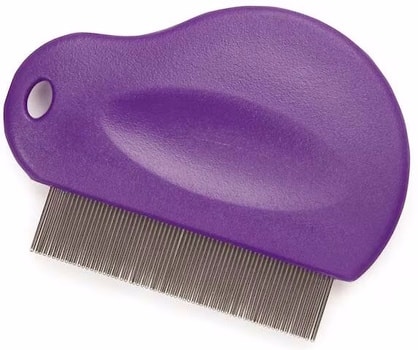
| Material: | Plastic, stainless steel |
| Features: | Ergonomic, contoured design |
| Weight: | 1.12 ounces |
The Master Grooming Tools Contoured Grip Flea Comb is a handy device for on-the-spot flea removal, designed with both pet owners and pets in mind. With its compact design, this comb fits conveniently in your pocket, making it a perfect tool for immediate usage during any bath or brushing.
Built with durable high-impact plastic, this comb is created to last, providing long-term flea control assistance. The ergonomic shape of this comb makes it comfortable to hold, and it contours perfectly to your hand, thus reducing hand fatigue during extended grooming sessions.
This flea comb works with close-set pins, which are designed to effectively remove fleas, flea eggs, and debris from a pet’s coat. The stainless steel material not only ensures its durability but also makes cleaning it a breeze. It’s also worth noting that it’s suitable for small pets like rabbits, chinchillas, guinea pigs, and more—a great fit for pet owners with a variety of animals.
- Ergonomic shape contoured for a comfortable grip
- Close-set pins for effective removal of fleas and debris
- Durable, made with high-impact plastic and stainless steel pins
- Suitable for both cats, dogs, and a variety of small pets
- May be uncomfortable for pets with very large or dense coats
- Best-seller; might be out of stock
10. Arbootjin 2 Pcs Flea Comb
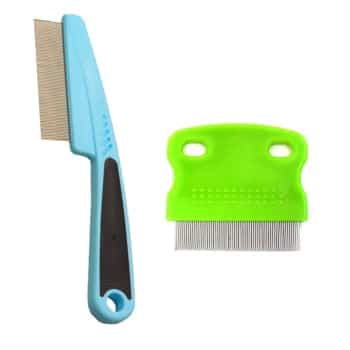
| Material: | Plastic, metal |
| Features: | Non-slip handle, ergonomic design |
| Weight: | 1.76 ounces |
The Arbootjin 2 Pcs Flea Comb is a practical and versatile grooming tool for your pet. Made of premium stainless steel, this comb is solid, durable, and wear-resistant, ensuring its reusability for years to come.
This set includes two flea/lice combs of different shapes, providing variety for different grooming needs. The handle of these combs features ergonomic plastic spots for an anti-slip grip. This special design makes pet grooming easier and more comfortable while preventing the comb from slipping out of your hand.
Overall, these are serviceable flea combs that should serve you well. While the quality isn’t on par with others highlighted here, this set is affordable and does what it’s supposed to do.
- Made of durable and wear-resistant material
- Includes two combs of different shapes
- Ergonomic, anti-slip handle for comfortable grooming
- Versatile for use on all hair lengths and types
- The handle’s plastic material may not be as durable as metal options
- Teeth don’t feel as secure as others
Buyer’s Guide for the Best Flea Combs For Cats
Got questions about flea combs? We put together this quick reference guide to walk you through the process of choosing a flea comb for your cat. Check out the tips below to help point you in the right direction.
- Type of Teeth: Flea combs come with either fine or extra-fine teeth. The type of teeth impacts how effectively the comb can remove fleas, eggs, and other debris. Combs with extra-fine teeth are typically more effective at removing these pests.
- Handle Design: The handle should be comfortable to grip, allowing for efficient combing without causing strain to your hand. Look for combs with ergonomic designs that offer good control.
- Material: Durability is a crucial factor to consider. The material of the comb should be strong enough to withstand regular use. Stainless steel teeth are typically more durable than plastic.
- Versatility: Some flea combs double as grooming tools, helping to remove loose hair, dirt, and tangles. This dual-functionality can be a bonus, providing more value for your money.
- Pet Compatibility: Consider your pet’s size and fur type when choosing a flea comb. Some combs are better suited for cats with short fur, while others are designed for long-haired breeds. Make sure to choose one that matches your pet’s specific needs.
A flea comb is a great tool for preventative maintenance and dealing with minor infestations. That said, severe flea problems may require a more comprehensive approach involving medicated shampoos or treatments prescribed by a veterinarian.
Conclusion
We’ve gone through a thorough review of the top 10 flea combs for cats, and it’s clear that they all have their unique merits. For instance, the Groomer’s Best Flea Comb from Hartz emerged as the best overall. Its dual functionality as a flea remover and grooming tool makes it highly effective and versatile.
Frisco’s Single-Row Mini Flea Comb offers the best value, making it a fantastic choice for pet owners on a budget. While affordable, it is highly effective at identifying and removing pests. Lastly, the Safari Flea Comb for Cats is our premium choice due to its feline-friendly design and multifunctionality. Its comfortable grip and fine teeth gently yet effectively remove pests.
As you can see, you have a lot of options to consider but one thing is certain—you can count on our top picks to be among the best of the best for your cat’s flea care and grooming needs.
Featured Image Credit: Simone Hogan, Shutterstock
Contents
- A Quick Comparison of Our Favorites in 2024
- The Best 10 Flea Combs for Cats
- 1. Hartz Groomer’s Best Flea Comb – Best Overall
- 2. Frisco Single-Row Mini Flea Comb – Best Value
- 3. Safari Flea Comb for Cats – Premium Choice
- 4. Le Salon Essentials Flea Cat Comb
- 5. H&H Pets Pin Comb 2.0
- 6. Yumflan Flea Comb with Rubber Handle
- 7. Pet Republique Flea Comb for Dogs & Cats
- 8. Frisco Double-Row Flea Comb
- 9. Master Grooming Tools Contoured Grip Flea Comb
- 10. Arbootjin 2 Pcs Flea Comb
- Buyer’s Guide for the Best Flea Combs For Cats
- Conclusion

